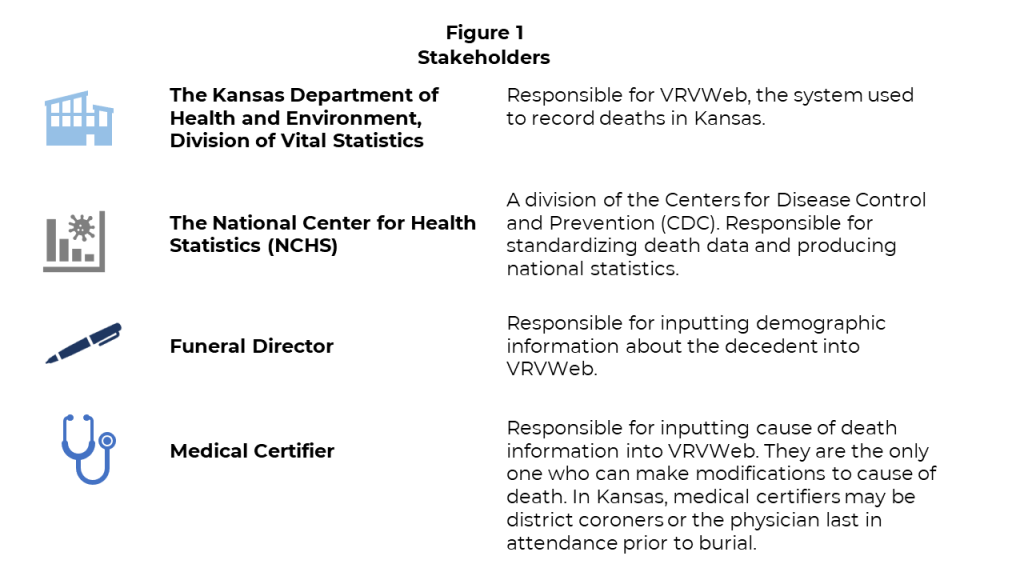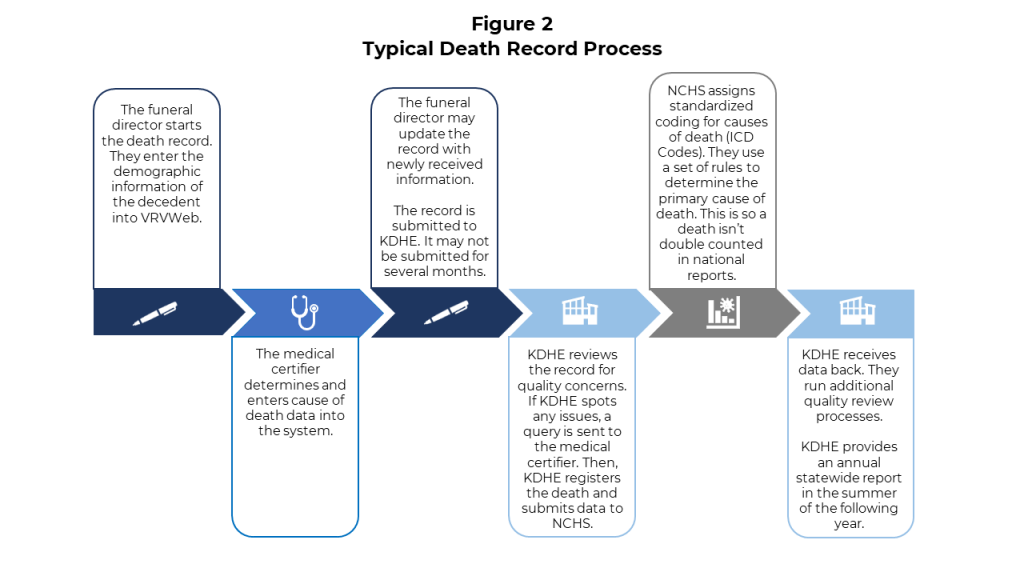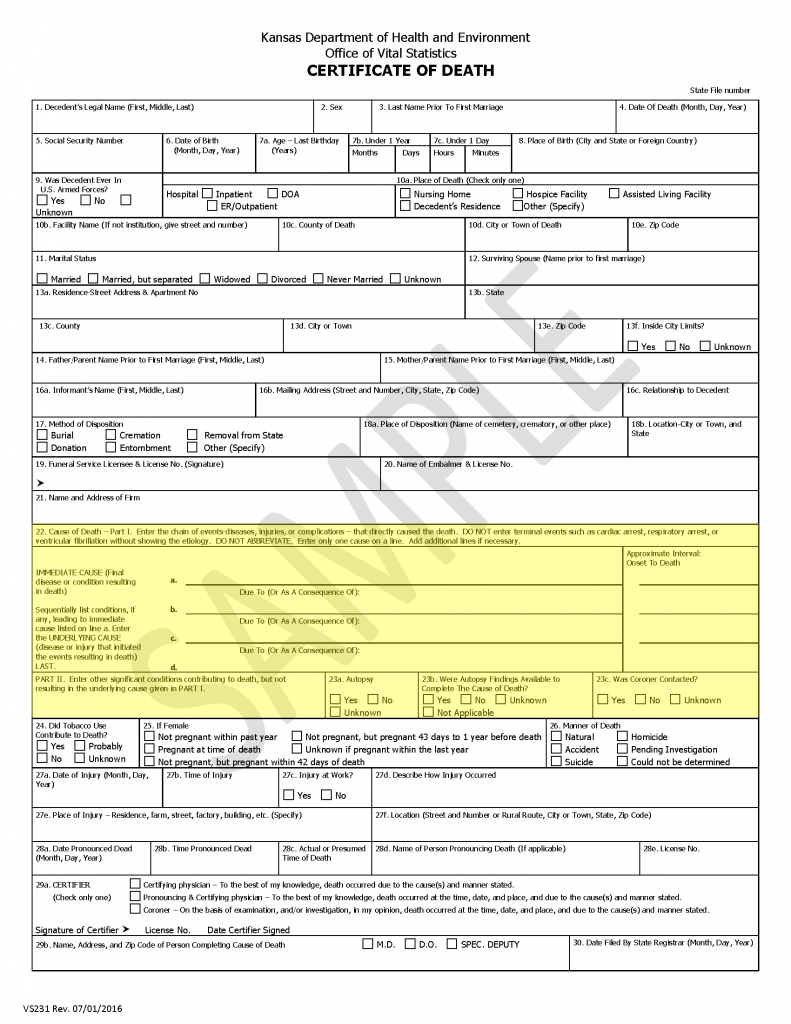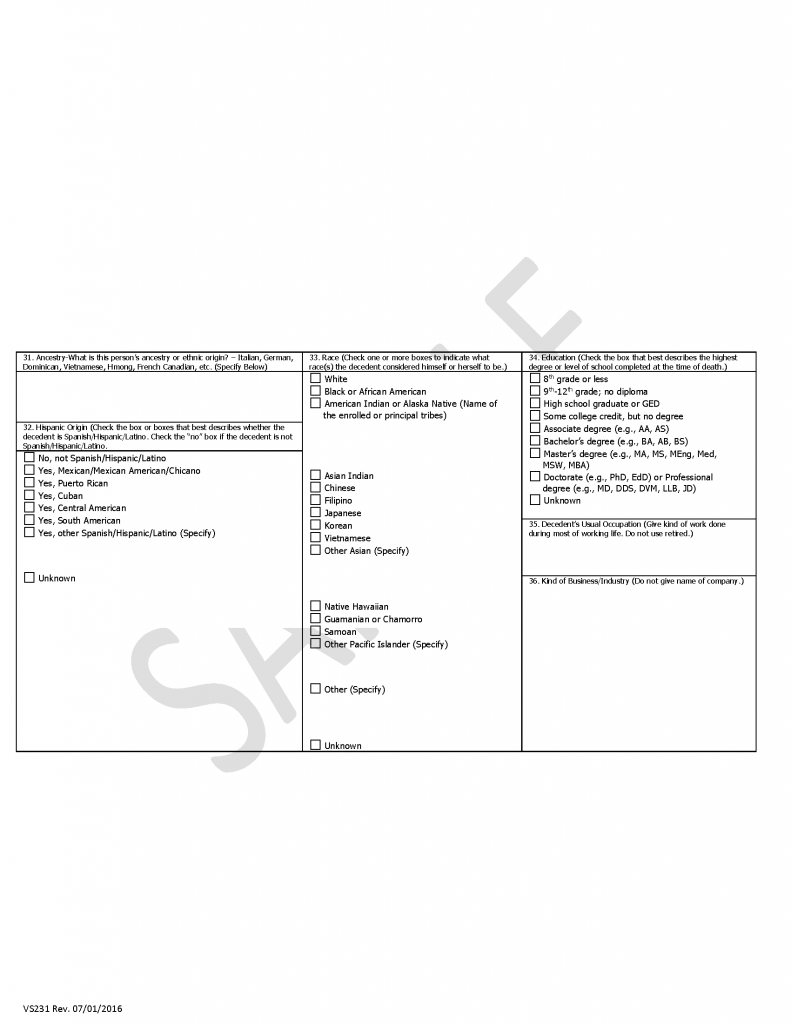Comparing the Impact of COVID-19 on Death Rates During Certain Months of 2019 and 2020
Introduction
Representative John Barker requested this limited-scope audit, which was authorized by the Legislative Post Audit Committee at its February 24, 2021 meeting.
Objectives, Scope, & Methodology
Our audit objective was to answer the following question:
- How did causes of death during the COVID-19 pandemic compare to those before the pandemic?
To answer this question, we reviewed death record data from 2019 and 2020 for the last third of each year (September 1 – December 31). At the time of our work, death record data for 2020 was provisional. That’s because death certificates take time to complete and can be subject to delays. Our findings may not include all deaths that occurred over this time period.
We interviewed staff at the Kansas Department of Health and Environment and staff at the National Center for Health Statistics about the process for recording causes of death and quality assurance measures. KDHE also provided us death record data. We tested the data and determined it was sufficient and appropriate to meet the audit objective. We did not audit systems used to submit or code death records. We also did not verify causes of death listed in death records.
More specific details about the scope of our work and the methods we used are included throughout the report as appropriate.
Audit standards require us to report our work on internal controls relevant to our audit objectives. Because this was a limited-scope audit, we did not test any internal controls.
Important Disclosures
We conducted this performance audit in accordance with generally accepted government auditing standards. Those standards require that we plan and perform the audit to obtain sufficient, appropriate evidence to provide a reasonable basis for our findings and conclusions based on our audit objectives. Overall, we believe the evidence obtained provides a reasonable basis for our findings and conclusions based on those audit objectives.
The leading causes of death didn’t change much from 2019 to 2020, except for additional deaths due to COVID-19.
Determining and recording cause of death involves funeral home directors, local medical certifiers, the Kansas Department of Health and Environment, and the National Center for Health Statistics.
- The Kansas Department of Health and Environment (KDHE) maintains the death recording system called VRVWeb. This is a web-based system that allows authorized users to enter and manage vital records data.
- When an individual dies, the funeral director is responsible for inputting demographic information about the decedent into this system. This includes information obtained from the family such as age, address, and social security number.
- The medical certifier (a local coroner or doctor) is responsible for inputting medical information into the system, including cause of death. The local medical certifier is the only one who can make modifications to the cause of death.
- Once the funeral director and medical certifier complete their portions, KDHE registers the death and submits the death record data to the National Center for Health Statistics (NCHS). NCHS codes the cause of death using a standardized system used nationally. This information is sent back to KDHE for recording and reporting.
- Figure 1 shows the stakeholders involved in the death record process and their roles.

- Figure 2 shows an overview of the death record process.

- Given the scope of this audit, we did not verify the processes officials at KDHE or NCHS described to us.
The National Center for Health Statistics (NCHS) uses a standardized system to determine the underlying cause of death.
- Many decedents have several causes or conditions that lead to death. The standard death certificate allows for multiple causes or conditions to be recorded. The medical certifier lists the causes or conditions sequentially. A sample death certificate can be found in Appendix B.
- The underlying cause of death is the disease or injury which triggered events leading directly to death. In cases of accidents or violence, it is the circumstance that caused the fatality.
- Determining the underlying cause of death is useful to help prevent similar deaths in the future. For reporting purposes, determining the underlying cause ensures a death is only counted once.
- The standardized process used by NCHS for coding and determining the underlying cause of death is largely automated. There are rules that help determine the underlying cause of death. Generally, it is determined by the sequence in which causes or conditions are entered into the death record.
- General examples of how the process works are listed below.
- If causes of death or conditions are listed on the death certificate by the doctor or coroner in this order:
a. Asphyxia
b. Crushed chest
c. Car accident
The system asks:
Can asphyxia be due to a crushed chest? Yes
Can a crushed chest be due to a car accident? Yes
A car accident would then be listed as the underlying cause of death.
- If causes of death or conditions are listed on the death certificate by the doctor or coroner in this order:
a. Acute respiratory distress
b. Viral Pneumonia
c. COVID-19
d. Diabetes
The system asks:
Can respiratory distress be due to viral pneumonia? Yes
Can viral pneumonia be due to COVID-19? Yes
Can COVID-19 be due to diabetes? No
COVID-19 would then be listed as the underlying cause of death.
- All causes of death are considered contributing causes of death, such as diabetes in the example above. However, there is only one underlying cause of death. The underlying cause of death is used by NCHS and KDHE in reporting leading causes of death.
The leading causes of death in Kansas for Sept. 1 – December 31 were similar for 2019 and 2020, except for additional deaths due to COVID-19.
- We reviewed death record data for September 1 – December 31 of 2019 and compared that to the same time period in 2020. Note: the death certificate data we reviewed for 2020 was provided in April of 2021. At that time, the data for 2020 was provisional. 2020 data may not be complete and is subject to change as additional information is received.
- We used NCHS standards for this work. There are thousands of very specific cause of death codes. For our analysis, we used NCHS guidelines to categorize those specific causes of death into more general categories.
- For reporting on leading causes of death, we used the underlying cause of death. We did not review contributing causes of death. The underlying cause of death is used by NCHS and KDHE in reporting leading causes of death.
- Using death record data as reported, we compiled a list of the leading causes of death in Kansas for the last third of each year. Figure 3 lists the leading causes of death for September 1 – December 31 in Kansas by year.
Figure 3
- As the figure shows, COVID was the leading cause of death for the period we reviewed in 2020. Otherwise, the leading causes of death in Kansas for that period remained mostly unchanged from 2019 to 2020.
- There were slight variations in the number of deaths by cause. For example, deaths due heart disease increased from 1,995 to 2,113 from one year to the next. We didn’t evaluate the reasons for these changes or whether they were statistically significant.
The increase in the number of deaths from 2019 to 2020 is largely attributable to COVID-19.
- Annual numbers reported by KDHE and NCHS indicate there were more Kansas deaths in 2020 than the number of deaths from either of the previous two years. Reports show that there were 27,213 deaths in 2018, and 27,312 deaths in 2019. Provisional data shows 31,096 deaths in 2020, a 14% increase from 2018 and 2019.
- In our review of the time period September 1 – December 31, there were 3,331 (36%) more deaths in 2020 than in 2019.
- Deaths with COVID-19 as the underlying cause of death accounted for most of the increase. For our review period, COVID-19 was listed as the underlying cause of death on 2,608 of Kansas death records in 2020. This accounts for 78% of the additional deaths in 2020. Figure 4 shows the number of deaths in 2020 as compared to 2019.
Figure 4
Both KDHE and NCHS officials told us they have processes to check the accuracy of death record data.
- Both KDHE and NCHS officials told us they conduct reviews to assess the reliability of death record data. This might include reviews for missing data, odd trends, or data that seems incompatible. For example, KDHE would flag the record if a female decedent who was 70 years old at the time of death, was shown as being pregnant in the previous year.
- Only the local medical certifier may change or update cause of death. Neither KDHE nor NCHS may change the official cause of death. When NCHS has a concern with death record data, they notify KDHE. Then, KDHE notifies the medical certifier (coroner or doctor) with concerns either they or NCHS have noted.
- Neither staff at KDHE or NCHS have access to medical record data to verify the cause of death.
Both KDHE and NCHS officials reported adding new review processes when COVID-19 is listed as the cause of death.
- NCHS staff told us they review all COVID-19 deaths a second time. NCHS staff compare codes assigned through NCHS processes to the death record to verify they match.
- KDHE told us they started a new process to match records from two separate systems. In Kansas, infections and deaths from specific reportable diseases such as measles, rabies, or COVID-19 must be reported by health care providers and laboratories to the KDHE reportable disease system.
- A team at KDHE compares COVID-19 deaths reported through this system to submitted death certificates. If a COVID-19 death is reported through the reportable disease system, but COVID-19 is not listed on the corresponding death certificate, the reportable disease system is updated.
- The death certificate is considered the official record of COVID-19 deaths.
Recommendations
We did not make any recommendations for this audit.
Agency Response
On May 13, 2021 we provided the draft audit report to the Kansas Department of Health and Environment. Agency officials did not provide a formal response or any corrections.
Appendix A – Cited References
This appendix lists the major publications we relied on for this report.
Appendix B – Sample Death Certificate
This appendix includes a sample Kansas death certificate, obtained from KDHE, with the cause of death section highlighted.


